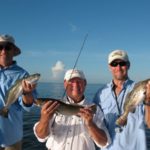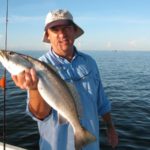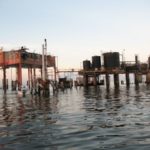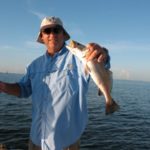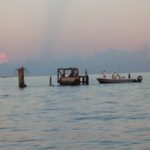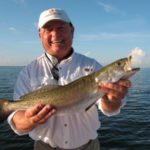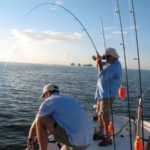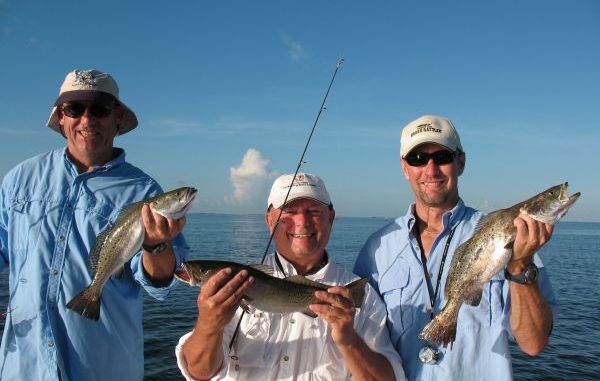
The words ‘September’ and ‘transition’ are almost redundant to trout anglers, but here are some tips on how to seine Black Bay for everything it’s worth.
September can pose some real challenges for trout fishermen. First, we have weather to contend with and, while that is true in any month, September is the peak of our tropical season — which brings winds and seas to a whole different level. Even when we don’t get nailed head-on by tropical systems, the very presence of one anywhere in the Gulf destabilizes the weather and makes for very windy and rough conditions for a week or more at a time. Then, there’s the “transition” thing speckled trout go through. It’s like trout menopause.
They disconnect from the schools they’ve been running with and scatter all over the place; they become very finicky about what they want — and will change their mind from day to day, or even hour to hour.
The live shrimp that attracts them today might repulse them tomorrow, and the plastics they wouldn’t touch yesterday is all they’ll hit today.
Go figure!
Then there’s the factor of higher water and tides that come along with tropical systems. Any system that pushes water levels up into the inside marsh will push the bait up into the inside waters, as well.
Combine that with their steadily growing instinct to transition to the inside anyway, and you’ve got a full-fledged migration on your hands.
The point: September can be challenging.
But it can also be productive. And if you’re willing to follow some simple advice, you can make this one a speckled-trout September to remember.
Recently, I managed to squeeze aboard one of Capt. Sean Cady’s (504-723-3229) charter trips for a trout hunting expedition into Black Bay. Cady had a two-boat party of anglers who were all related and who fish together around the country.
We met up well before daybreak at Serigne’s Marina on Delacroix Island, and after brief introductions all around I climbed aboard Cady’s 22-foot Triton Bay Boat and he pointed the bow straight down Bayou Terre aux Boeuffs.
I was fishing on the boat with Cady, Freddie and Adrian Sandel (first cousins out of Natchez, Miss.), who agreed to let me tag along on their trip. More cousins were following right behind us in another boat.
Cady pretty much grew up plying the waters of the Delacroix Island and Pointe a la Hache area, and he’s been guiding professionally for some 15 years in the area. His plan was to head straight to Black Bay, run past the closer islands and structures, and set anchor at Battledore Reef, where he said he’d been on a good trout bite.
On the ride out we talked about September fishing.
“September is called a transition month because the trout are beginning to switch locations, from the deeper waters around wells and rigs to the fringe area reefs and islands and structures,” Cady said. “Usually, we begin to see them moving inside by mid August.
“The smaller trout move inside first, many not quite keeper-size, yet. But there will be some keepers in the mix. Then the mid-sized fish will begin moving closer to the inside, showing up around the marsh islands and over the oyster reefs, and gradually working into the mid-range lakes. Then by fall the inside will explode with hungry trout. It’s a great time of year to fish. But I’m going to be heading outside this month, probably all month long, to try to find the bigger trout that will linger a while longer at the rigs and islands in the bigger water.”
The key to staying on these big fish is their preferred food.
“The bigger fish will stay outside as long as the shrimp and baitfish are out there,” he explained. “The one factor that will change everything is a tropical storm. If we get a storm big enough to send water up over the banks and roads in lower St. Bernard Parish, you know, in Hopedale, Delacroix, Shell Beach — the areas outside the levee system — the shrimp will all be pushed deep inside into the marshes and all the trout will move inside.
“You’ll catch all the trout you can keep in Little Lake this month if that happens. Otherwise, you’ll want to make the trip outside to the usual summer hotspots to find the better fish.”
Forty-five minutes later we arrived at one of Battledore’s two big rigs. We pulled away from the dock before daybreak to get on the action early, but six boats were already there — and I could see several others making their way to the same rig.
We were obviously in the hot spot.
I noticed several different charter boats there, all around the front of the rig at different spots, and, most importantly, everyone seemed to be catching fish.
Cady got us into a position where we could cast without interfering with the neighboring boats, and the guys following us anchored a good bit off from us. We tossed live shrimp about 2 to 3 feet under a cork, and we immediately got some hook-ups.
But mostly all small trout, with several throwbacks among them.
After 15 minutes or so of small fare, Cady decided to move us to the backside of the rig. Nobody else was fishing there, so I figured we were trying an inferior spot.
But in minutes we started catching trout, and these were no throwbacks.
Rod after rod doubled over, and hefty specks started flying into the boat. Cady was non-stop motion, taking fish off the line, re-baiting hooks and netting fish, and he was doing some serious clicking on the fish counter.
There were several other boats within my line of vision, and every one of them was duplicating our success.
This rig was swarming with fish.
The action continued along the backside of the Battledore rig, but it went from fast-and-furious to sporadic. We’d catch a few in a row, and then the action stopped for 10 minutes or so.
And then we’d have another flurry of quick action. Cady said it’s typical that the action becomes more sporadic as the morning wore on.
“The fastest action is usually early in the morning, and then as the hours pass the action slows down until it stops altogether,” he said.
I looked around the rig and could see some boats had already pulled up anchor and were moving.
But we stayed, and rightly so — even though our action had slowed, we were still steadily adding fish to the box.
And Cady said these trout were the biggest he’d caught yet at the rig.
The Wreck
Considered a summertime hotspot for big trout and redfish, the Wreck and the surrounding structures can still be very productive in September.
“The thing to remember is, in September, you want to stay farther off from the rig than you usually do,” Cady said. “The fish tend to hang farther off the main structure, so forget about fishing it up close. Back off 30 to 50 yards, anchor and fish live shrimp under a cork or on the bottom. Try both ways, and try free-lining a live shrimp with just a split-shot about 6-8 inches above the hook. Sometimes the finicky trout will hit that and ignore everything else. They get weird in September.”
Iron Banks
“The Iron Banks has been very productive this summer, but in September the action there tends to slow down,” Cady said. “You might still catch some fish there, but it’ll be spotty at best, and completely non-productive at worst.
“Unless I hear of some good action still coming from there, I’ll probably avoid it this month.”
Stone Island, Lonesome Island
“These are two great areas for big trout, and they can still be productive in September,” the veteran guide said. “The key here is water quality, water movement and quiet. This is shallow water fishing, so noise becomes a factor, and by September the bigger fish are pretty skittish.”
Best options are pretty basic.
“Troll and drift, toss a live shrimp under a cork, or a topwater bait, especially in the early mornings or on cloudy days, and stick as quietly as possible when you find fish,” Cady said. “A Power-Pole, Cajun anchor or regular anchor used quietly will all work.
“Just remember, in shallow water sound really travels and scatters the fish. Many a time I’ve been on a good bite out there and some knucklehead will roar straight in with his outboard wide open and shut down at the last moment, sending a huge wake, and then they’ll drop anchor as if success depends on how much noise you make. You might as well pick up because that’s the last of the bite when that happens.”
Cady said the surrounding structures can also produce some nice catches.
“Not all of the satellite wells will hold fish, but many of them do — especially the ones with the nice big shell pads around them,” he said. “If you don’t know if it has a good shell pad or not, use your depth finder and troll around the wellhead. If you see a distinct rise in the depth under you, that’s the reef.
“Often you’ll see some good trenches where the tidal movement has scoured the bottom. That’s also a good place to drop a bait.”
Black Tank
Not much is left of the old Black Tanks structure, once a bonanza for speckled trout anglers. But some pilings and a chunk of barge remain, and those remnants still attract some trout.
Fish live shrimp under popping corks around the pilings and remnant structure.
“Give it 15 minutes or so to settle down and produce after you anchor up and settle in,” said Cady. “If nothing bites, move on.”
Battledore Reef
According to Cady, Battledore usually comes alive in late July and throughout August — and that action often continues well into September.
“It’s affected a whole lot by the river, so a high river will cover the whole area in muddy water and send the trout packing,” he said. “Last year, the river was exceptionally high and Battledore didn’t do much. But this year has been just the opposite.
“The low river has allowed seawater into the area and — along with the good, salty water — lots of bait, and that means lots of trout. I expect to catch some good fish at the big rigs, and the smaller wells and structures through September, barring a tropical system.”
His strategy for success here continues to center around shrimp.
“I’ll fish the bigger structures first with live shrimp under a popping cork, and then I’ll try a variety of the smaller satellite structures,” Cady said. “I look for mostly older structures, those that have a decent shell pad around them.
“Use your depth sounder to see if you can locate a rise from the average bottom depth. That’s a shell reef, and that’ll hold bait and trout. Fish there.”
Capt. Sean Cady can be reached at 504-723-3229.
